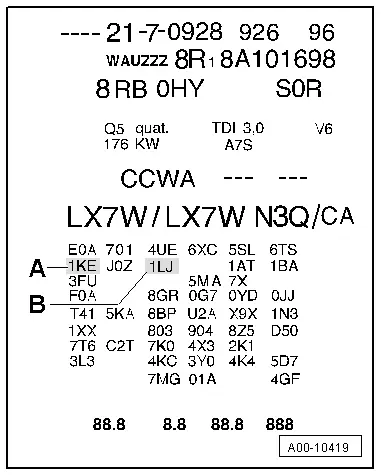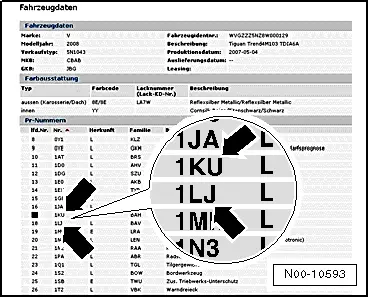Audi Q7: General, Technical data
Identification
PR Number Allocation - Brakes
Vehicle Data Label
Which brake system is installed in the vehicle is among other documented by the PR number on the vehicle data label.

A - Rear Brakes (Example)
B - Front Brakes (Example)
Vehicle data label component location.
ELSA/Vehicle-Specific Notes
The relevant information regarding each brake installed can also be retrieved via ELSA/vehicle-specific notes.
- 1KU - Rear Brakes (Example)
- 1LJ - Front Brakes (Example)
- Allocation. Refer to the Parts Catalog.
- Refer to → Chapter "Technical Data" for the PR number code key. These are important for the brake caliper/brake rotor and brake pad combination.

Safety Precautions
Safety Precautions when Working on Vehicles with Start/Stop System
Note the following when working on vehicles with a Stop/Start system:
 WARNING
WARNING
There is a risk of injury if the engine starts automatically in vehicles with a Start/Stop System.
- For vehicles with an activated Start/Stop System (recognizable by a message in the instrument cluster), the engine may start automatically as needed.
- Make sure that the Start/Stop System is deactivated when working on the vehicle (turn off the ignition, turn on the ignition when necessary).
Safety Precautions during Road Test with Testing Equipment
Note the following if testing equipment must be used during a road test:
 WARNING
WARNING
Distractions and testing equipment that is not secured properly can cause accidents.
There is a risk of the front passenger airbag deploying during an accident.
- Operating testing equipment while driving is a distraction.
- There is an increased risk of personal injury if testing equipment is not secured properly.
Always secure testing equipment on the rear seat with a strap and have a second person on the rear seat operate them.
Repair Information
Guidelines for Clean Working Conditions
- Absolute cleanliness is required when working on the ABS. Using any products which contain mineral oil such as oils, greases etc. is strictly prohibited.
- Thoroughly clean all connection points and their surrounding areas before loosening. However, do not use aggressive cleaning agents such as brake cleaner, gasoline, thinners or similar compounds.
- Place the removed parts on a clean surface and cover them.
- Carefully cover over opened components or seal, if repairs are not performed immediately (use sealing plugs from Assembly Part Set -5Q0 698 311-).
- Only use lint-free cloths.
- Remove the replacement parts from their packaging just prior to installing them.
- Only use parts in their original packaging.
- If the system is open, do not work with compressed air and do not move the vehicle.
- Make sure that brake fluid cannot get into the connectors.
General Repair Information
- Hairline cracks on the brake rotor friction surface are often observed during brake repairs. Hairline cracks up to 10 mm long are not a technical flaw and are not cause for brake rotor replacement.
- Brake rotors with brake pads that have worn through should be replaced.
Contact Corrosion
Contact corrosion can occur if incorrect fasteners (bolts, nuts, washers, etc.) are used.
For this reason, only fasteners with a special surface coating are installed.
In addition, rubber or plastic parts and adhesive are made of materials that do not conduct electricity.
If there are doubts about whether parts can be used or not, then use new parts. Refer to the Parts Catalog.
 Note
Note
- The use of Audi original replacement parts is recommended, since they are tested and approved.
- The use of Audi original accessories is recommended.
Technical Data
Technical Data, Brakes
 Note
Note
The brake system is divided by axle. Right and left front. Right and left rear.
Brake System

Front Brakes

1) Brake pads wear limit.
Rear Brakes

1) Brake pads wear limit.
Brake Inspection
General Information
 Note
Note
- On this vehicle the brake system is divided by axle.
- Right and left front axle
- Right and left rear axle
- The operation takes place on a test stand.
- When checking the "N" position must be engaged.
- Always follow the instructions from the test stand manufacturer.
 Note
Note
Pay attention to the instructions on the screen of the test stand.
 Note
Note
Electronic brake control systems are inoperative when the "ignition is switched off".
AWD Vehicles, Checking
 Note
Note
Pay attention to the instructions on the screen of the test stand.
Testing on a One-Axle Roller Test Stand for AWD Vehicles
- During this test, the wheels of one axle are driven in opposite directions, to prevent delivering power to the other axle.
- The test speed must not exceed 6 km/h, otherwise, the brakes may lock up due to the roller start-up delay (EDL regulation).
- Test stands approved by Audi meet these requirements.
Parking Brake, Checking
 Note
Note
Pay attention to the instructions on the screen of the test stand.
Activating "TÜV mode":
- The seat belt is buckled.
- Rear axle in the one-axle roller test stand
- The engine is off and the ignition is on.
- Auto Hold is off.
- The front wheels must be stationary.
- The rear wheel must rotate for at least five seconds non-stop between 2.5 through 9 km/h (1.5 through 5.6 mph)
"TÜV mode" is indicated when the yellow Electric Parking/Hand Brake Malfunction Indicator Lamp -K214- is displayed.
- The yellow electro-mechanical parking brake symbol with a line through it appears in the instrument cluster. Refer to the Owner's Manual, Instruments and Indicator Lamps.
 Note
Note
The electromechanical parking brake does not close completely immediately in the "TÜV mode".
Operating the Electro-Mechanical Parking Brake Button -E538- three to four times increases the tension in stages.
Operating the Electro-Mechanical Parking Brake Button -E538- a fifth time loosens the electro-mechanical parking brake.
- Start the engine and wait approximately five seconds until there is enough vacuum.
Ending "TÜV mode":
- Front wheels, speed greater than 0 km/h
- Rear wheels, speed less than 2.5 km/h (1.5 mph) or greater than 9 km/h (5.6 mph)
- Ignition off.

